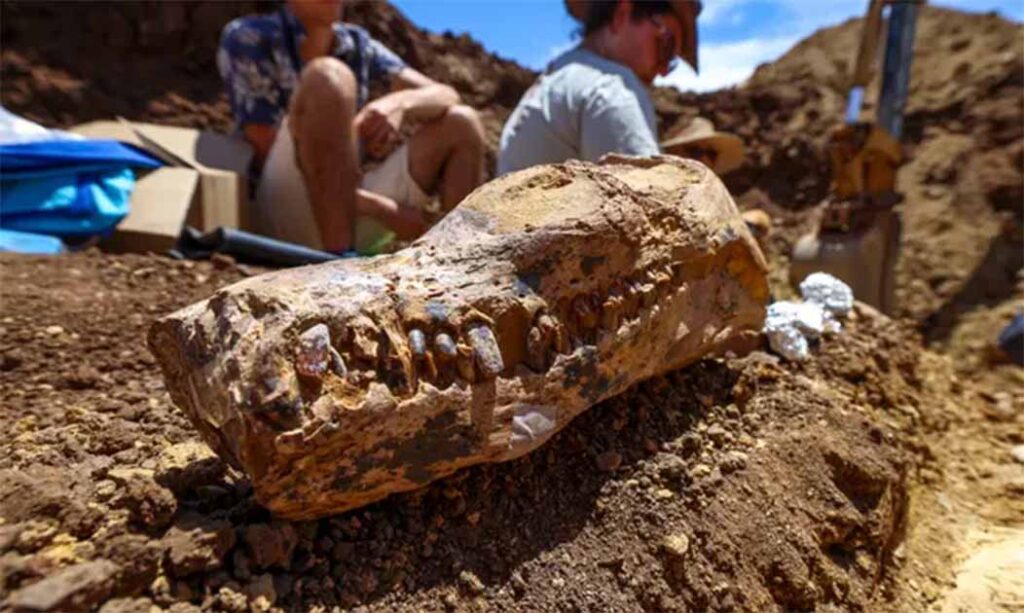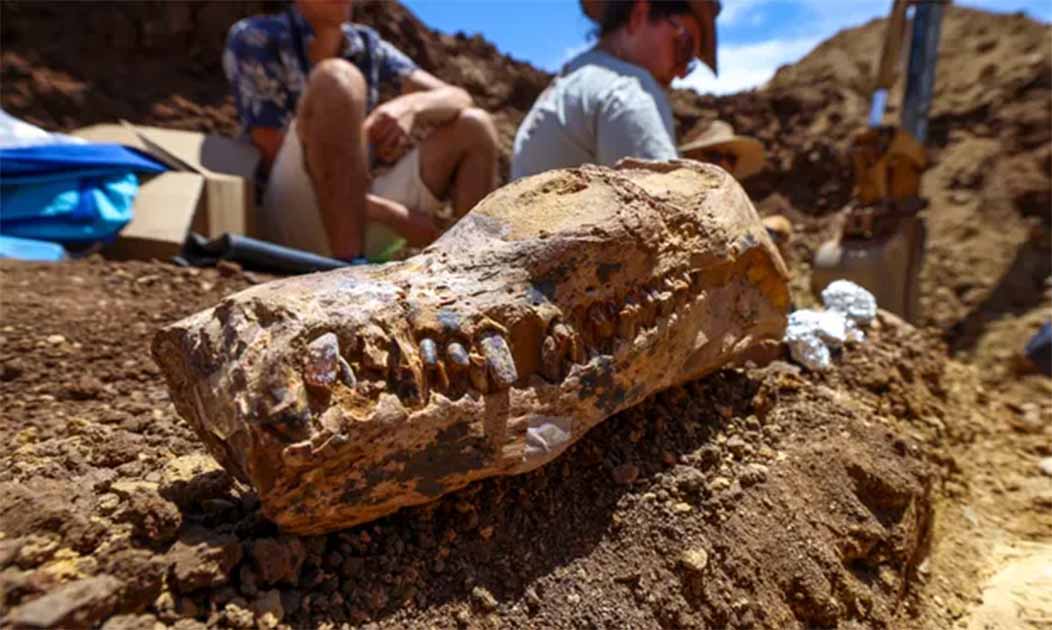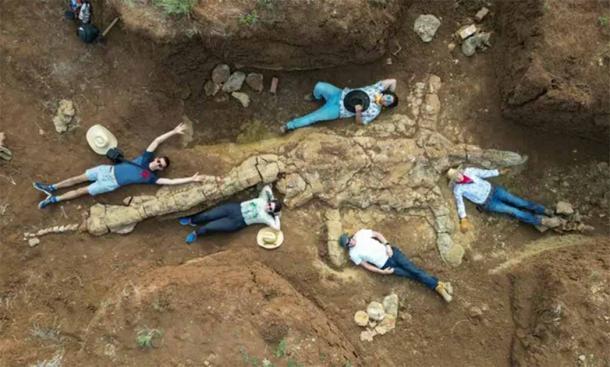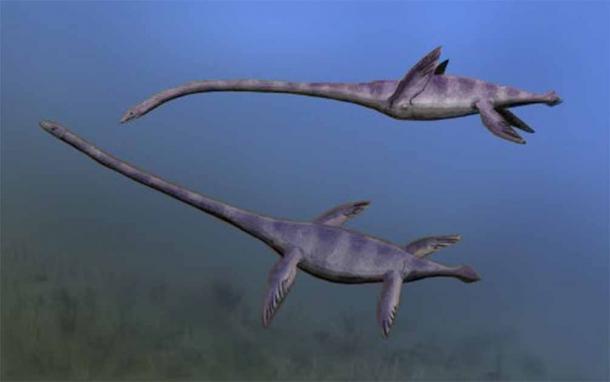

Paleontologists affiliated with the Queensland Museum Network in Australia have unearthed both the head and body of a 100-million-year-old marine reptile known as an elasmosaur. This astonishing creature lived in the shallow sea that covered Queensland during the early Cretaceous period (145 million to 65 million years ago). This is an extraordinary and important find, since this is the first time the fossilized head and body of an elasmosaur have been found together in Queensland, and the fact that all the fossilized bones were in excellent condition is an amazing bonus.
Rancher Alerts Authorities to Huge Discovery
The unusual fossils were excavated on remote ranchland in the farthest western reaches of Queensland, near the small outback town of McKinlay. The Queensland Museum Network paleontologists were alerted to the presence of the fossils by the ranch’s owner, who sent images of the only partially covered elasmosaur remains to the researchers for further analysis.
The experts recognized the images they received as the fossilized head of a huge marine reptile of some type. They rushed to the location to dig out the ancient remains completely, and that’s when they realized they’d recovered something special.
“We were extremely excited when we saw this fossil – it is like the Rosetta Stone of marine paleontology, as it may hold the key to unravelling the diversity and evolution of long-necked plesiosaurs in Cretaceous Australia,” stated Queensland Museum Network’s Curator of Paleontology Dr. Espen Knutsen, who organized the recovery of the elasmosaur fossils, in a Queensland Museum press release. “We have never found a body and a head together and this could hold the key to future research in this field.

‘Rock Chicks’ and other investigators with the amazing elasmosaur in situ in deepest Western Queensland. (© Queensland Museum)
The Rosetta Stone of Australian Fossils
The three-dimensionally preserved state of the elasmosaur fossil is what gives it its value. Its condition will let paleontologists make new discoveries about elasmosaur anatomy, and with that knowledge they will be better able to identify the true identity and purpose of other elasmosaur bones currently held in museum collections.
The elasmosaur is a type of plesiosaur, and like others of this order it had a long, extended neck and flippers on the side similar to those of a turtle.
Scientists have been curious about whether prehistoric plesiosaurs and other large marine reptiles used their long necks and teeth to reach down and filter crustaceans and other bottom-feeding lifeforms from the ocean floor, scooping them out and consuming them in large quantities. They’ve also wondered whether such creatures used their gigantic flippers to cruise along established migration trails, in the same manner as modern whales.
Answers to questions like these might be more easily forthcoming, thanks to the discovery of this “Rosetta Stone” fossil that can be used to interpret other finds and determine the true anatomical functions of various elasmosaur body parts.
“We will be able to unravel all that taxonomy that has eluded us up until now,” Knutsen said, summing up the transformational meaning of the find.

Elasmosaurus platyurus swimming with long, straight necks. (Nobu Tamura/CC BY-SA 3.0)
The Rock Chicks Got There First
One additional fascinating aspect of this discovery is the identity of the discoverers. The landowner who sent the images to Dr. Knutsen and his fellow researchers was Cassandra Prince, who along with her sister Cynthia and cousin Sally like to spend their spare time hunting fossils in the outback Queensland region where they all live. The three amateur paleontologists have dubbed themselves the ‘Rock Chicks,’ and this is not the first time they’ve found fossilized bones on Prince’s sprawling western Queensland cattle station. In fact the trio had already found fossilized plesiosaur remains a few weeks earlier, so they were quite aware of the possibilities.
In this instance what Cassandra Prince saw was a fossilized skeletal head staring up at her from the dry desert earth.
“I’m like, no, you know, this is not real,” Prince told the Guardian. “And then I look down again and I’m like, holy hell, I think that’s a skull looking up at me.”
Prince took pictures of the skull and then immediately sent them to Dr. Knutsen, who she’d been in contact with frequently reporting other fossil finds on her land. The paleontologist quickly identified the skull as belonging to a plesiosaur, and from its superior condition he knew right away it was something unique. But he and the other Queensland Museum Network paleontologists didn’t realize just how unique it was, until they dug it out and found both the head and body were intact.
A closer examination revealed the fossils had come from a elasmosaur juvenile, which would have been 16-23 feet (five-to-seven meters) long at the time of its death. The fossil will be removed and displayed at the Queensland Museum, and it has been given the name ‘Little Prince’ in honor of its actual discoverer.
An Unusual Death Made the Difference
As Dr. Knutsen noted, the anatomical features of plesiosaurs explains why it is so difficult to find fossilized skulls still connected to the rest of the body.
“Because these plesiosaurs were two-thirds neck, often the head would be separated from the body after death,” he said.
When an elasmosaur living in the ancient Queensland sea would die, its decomposing body would float to the surface. From there it would be picked apart by scavengers and bounced about by waves and tides, which could easily separate the head from the neck and the body. Even if the head remained attached, when the body eventually sunk to the ocean bottom the head could be several meters away from the body in the mud, and over time the decay of organic matter would create a separation between the skeleton of the body and the skeleton of the head.
For these reasons, it would be hard for paleontologists working 100 million years in the future to recover the entire skeleton together.
This newly discovered elasmosaur had its skull, neck and front half of the body preserved. However, the back half of its body had been bitten away, possibly during an attack by a much larger marine predator. Dr. Knutsen believes the offender would have been a massive kronosaur, and he noted that a elasmosaur killed by this type of attack would have sunk to the bottom of the ocean instantly. In this unusual state, perhaps it was less vulnerable to the natural forces that would have normally separated the head from the rest of the body.
Over the next few years, paleontologists will be studying the elasmosaur skeleton very closely, to see what can be discovered about its life, death and anatomical and behavioral characteristics. What they discover could help answer many questions about all the giant marine creatures that occupied the long-extinct Queensland Ocean in the impossibly distant past.